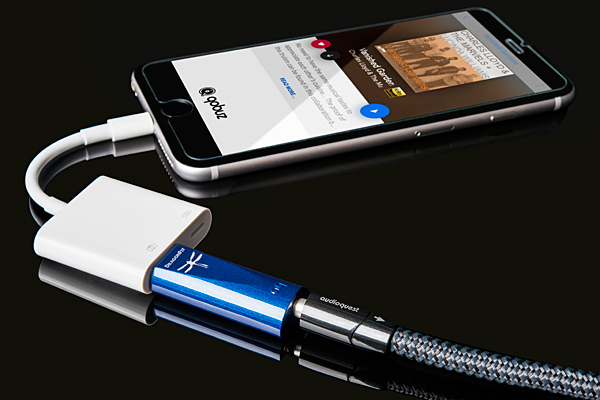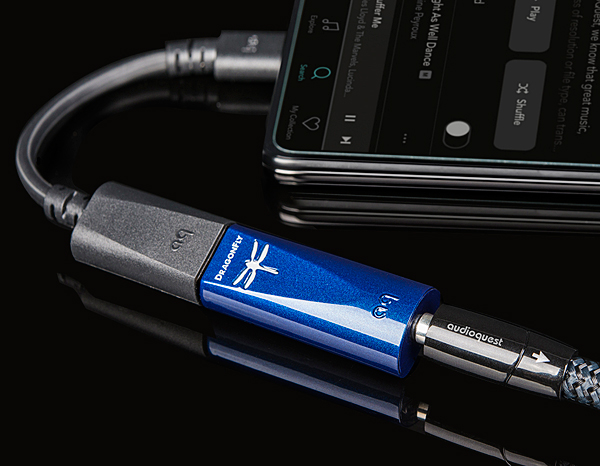| Columns Retired Columns & Blogs |
Best thing to happen to smartphone music since smartphone music ......... AQ DragonFly :-) .........
As you can see from this review's Measurements sidebar, while the Cobalt is specified as being able to deliver a maximum output of 2.1V, this is into high impedances. When the Cobalt is required to drive lower impedances, the volume control has to be backed off to avoid clipping the DAC's output amplifier. With the AudioQuest NightHawk headphones, which have an impedance close to 23 ohms across the audioband, I found that setting the volume at 55% (–14dB) gave usefully loud levels without any audible problems. The massive chords at the end of my 2014 recording of Jonas Nordwall's performance of Widor's Organ Symphony No.5 (24/88.2 ALAC file, footnote 1) crackled a little at volume control settings above "70" (–9dB), but the music was unlistenably loud in any case. And on "Rock and Roll" from Led Zeppelin's How the West Was Won (24/48 ALAC file), I had to back off the volume a little with the NightHawks to avoid my brain emulsifying.
With the Audeze LCD-Xes, which have an impedance of 22 ohms and are a little less sensitive than the AudioQuest cans, setting the volume control to "60" (–12dB) gave a volume that was as loud as I wished to hear with the Led Zeppelin track. And the DragonFly Cobalt didn't have any problems holding on to the massive 16' organ pedals on the Widor recording with the current-hungry Audeze headphones.
If using the Audeze headphones with the Cobalt seemed an incongruous match when playing music directly from my Roon server, how about when I plugged the pair into my iPad Mini, using an Apple Lightning to USB adapter (footnote 2), and streamed music from the Nucleus+ via Wi-Fi?

Listening to Rachel Podger performing Vivaldi's Violin Concerto in A minor, Op.4 No.4, with Arte dei Suonatori from La Stravaganza (24/96 FLAC file, Channel Classics CCS 19598), the sound was less full-bodied and a touch more grainy than it had been with the USB connection from the Roon server. However, it is fair to note that the Roon app now controls playback volume with the iPad's volume control, not that of the DragonFly, as the app can't "see" the AudioQuest DAC.
When I selected a DSD file with the Roon app, like "Take Five" from the Dave Brubeck Quartet's Time Out (DSD64 file, Columbia), the Nucleus+ first converted the data to 352.8kHz PCM, then converted the sample rate to 88.2kHz and the bit depth from 64-bit float to 24-bit integer, before sending it over my network to the iPad. The DragonFly Cobalt's logo accordingly turned yellow. But despite all this digital signal processing, the sound with the iPad Mini feeding USB data to the Cobalt was clean and clear, if again less authoritative-sounding in the bass than it had been with the USB connection from the Roon server. Even so, the sound was sufficiently compelling to distract me from reading 99% True, Paul McGowan's autobiography, which I reviewed in the November issue, on the iPad.
One difference I noted between sourcing MQA data from the Nucleus+ via USB and sending it to the iPad Mini via Wi-Fi was that, as the iPad has no MQA capability, Roon unfolded MQA data to the source file's specified sample rate but then converted it to 24/88.2 or 24/96 before transmitting it over the network. With the iPad sending the MQA-encoded version of my 24/88.2 recording of the Portland State Chamber Choir performing Eric Whitacre's "Water Night" via USB to the Cobalt, the DAC's logo illuminated yellow rather than purple and the presentation didn't have quite the palpability it had with the USB connection from the Roon Nucleus+. This might be because the Cobalt is no longer able to apply the appropriate MQA filter.
Comparisons
The obvious comparison is with AudioQuest's DragonFly Red, which I have been enjoying for a long while. With the Red and the Cobalt fed data via USB from the Nucleus+ and playing at the same level through the Audeze headphones, the Rachel Podger Vivaldi violin concerto sounded a little lighter-balanced on the Red, as did the double bass on the Bill Evans track. The latter also sounded less well-controlled in the upper bass, sounding less distinct overall. Even so, the Red coped well with the deep organ pedal notes on my Widor recording, though returning to the Cobalt extended the extreme low frequencies a little more.
Overall, the differences between the two AudioQuest DACs were relatively small, but I preferred the Cobalt for long-term listening, the Red's presentation sounding slightly "harder" in the highs.

My long-term reference for headphone listening is the PonoPlayer, which I reviewed in April 2015. No longer available, the PonoPlayer used to be priced at $399 and excels in conveying music's rhythmic drive, coupled with excellent presentation of recorded detail.
Using my Ultimate Ears 18 Pro in-ear monitors and matching levels by ear, I compared the DragonFly Cobalt driven via USB from the Roon server with the PonoPlayer. (While the UE18's impedance drops to 11 ohms between 7kHz and 12kHz, the Cobalt's volume control needed to be set well below the level where there might have been any danger of clipping—see "Measurements.") On "Take Five," the reverb around Joe Morello's kickdrum was more audible with the Cobalt than it was with the Pono. The drum also had a touch more low-frequency weight with the DragonFly. Paul Desmond's alto sax sounded slightly warmer with the Pono, though ride and splash cymbals had a little less top-octave "ssss." With the Cobalt, Daft Punk's "Lose Yourself to Dance" (24/88.2 ALAC file from Random Access Memories, Columbia/HDtracks) had both more low-frequency authority and low-frequency extension than it had with the PonoPlayer, though if I had to swear to it on my copy of Stereophile's first issue, the Pono's upper bass had a tad better rhythmic momentum.
Conclusions
Is AudioQuest's DragonFly Cobalt worth the extra $100 compared with the DragonFly Red? Yes. That sense of ease it offers with long-term listening is something I don't want to do without. The DragonFly Cobalt has replaced the DragonFly Red as my eBook-reading companion.
Footnote 2: AudioQuest says that Apple's Lightning to USB 3 Camera Adapter (with charging port) sounds better and is more reliable than Apple's less expensive Lightning to USB Adapter, while also providing the ability to charge during playback.

Best thing to happen to smartphone music since smartphone music ......... AQ DragonFly :-) .........

That is something that is often overlooked in comparing audio components. Small differences get much more noticeable over time.

That is something that is often overlooked in comparing audio components. Small differences get much more noticeable over time.
Jim Austin examines the relevance of long-term listening in his "As We See It" essay in the January 2020 issue.
John Atkinson
Technical Editor, Stereophile

I've been gifting the Dragonflys since their introduction.
People love them, use them 100% of the time, look for them if they get misplaced and keep thanking me for them.
I've also given WristWatches from Long Island Watch. ( which tend to be nice but forgotten )
The cute little Dragonfly is what people mention to me.
The people, I gift, are not Audiophiles but won't listen without the Dragonfly plugged in. It significantly improves Sound Quality and always leads to "better" headphones. ( our people are buying and showing new headphones, constantly, it's exciting )
Overall, I'd say and think that these Dragonflys are probably "Gateway" devices to Audiophile "leanings", it presents music as a beautiful & accessable life component. In one case the Device led my recipient to purchase a record player. ( unintended consequences , oh dear ! )
Now, I "have-to" use the blue one ( instead of the dreaded RED one ) for nonsense political reasons.
And...
The Blue one is pricier to gift, darn it. ( I could just give the Black one which would be even better politically, if they still offer it )
Tony in Venice
ps. this thing has to be a respectable Audiophile device if the Editor of the World's most Authoritative Audiophile Journal owns one. Isn't JA1 the highest Authority that we Audiophiles had ? ( jus say'n ) Of course JA2 is equally brilliant and is also brave enough to take sides with MQA and the lovely Devialet stuff.
ps.2) Audioquest probably SHOULD gift every Dragonfly purchaser with a ONE Year Subscription to Stereophile, they'd be doing themselves and everyone else a HUGE favor!

JA1 is Apollo and JA2 is Orpheus :-) .......

I bought a couple of the original Audioquest Dragonfly units before any of the colored models were released. Performance is adequate for casual background listening, and I like the small form factor for some applications, but also that small form forces some compromise in some other applications (adapting mini-plug connectivity, lack of balanced output, lack of external volume knob, etc.).
For non-portable applications, look at the SMSL-500, $399 on Amazon.
https://www.audiosciencereview.com/forum/index.php?threads/smsl-m500-dac-and-hp-amp-review.9606/
SMSL-500 can sit on a table next to the listening chair, can drive most headphones, has external volume knob, and includes balanced output on the rear which can drive longish interconnects to amplifiers located adjacent to the loudspeakers.


For balanced XLR interconnects, look at Monoprice's Stage Right starquad microphone cable, XLR-M to XLR-F, gold plated contacts, 24AWG, 10ft, black, available in wide variety of lengths from 1.5_ft to 100_ft. The 50_ft length is priced under $20/cable, with two cables needed for stereo pair. Microphone cable works well for balanced interconnections, but tends to be more flexible, smaller in diameter, yet also more durably rugged in construction.

For non portable applications, one could also consider ......... the new, iFi Audio Zen DAC/headphone amp $130 :-) .........

If you want both SS and tube flavors, you can check-out iFi Audio Pro iDSD desk-top DAC/headphone amp ($2,499) reviewed by Stereophile :-) .........

Focusrite Scarlette 2i2 and the Steinberg UR22 USB 24192 interfaces. At about $150 each I would like to see how they compare as they are both I/O devices with built in Mic Preamps. I love mine even just for listening to computer audio. You can even use them for line level inputs.

I do have an original DragonFly v1.0 in my laptop bag, if I ever need a better listening experience on the go, which has been a rarity lately. As cool as the Cobalt seems, after getting burned for the initial $250 of the original, I'll wait for the price to come down, when the DragonFly Mauve is introduced. Great review, JA1!

https://gearpatrol.com/2019/12/13/best-new-products-of-2019/